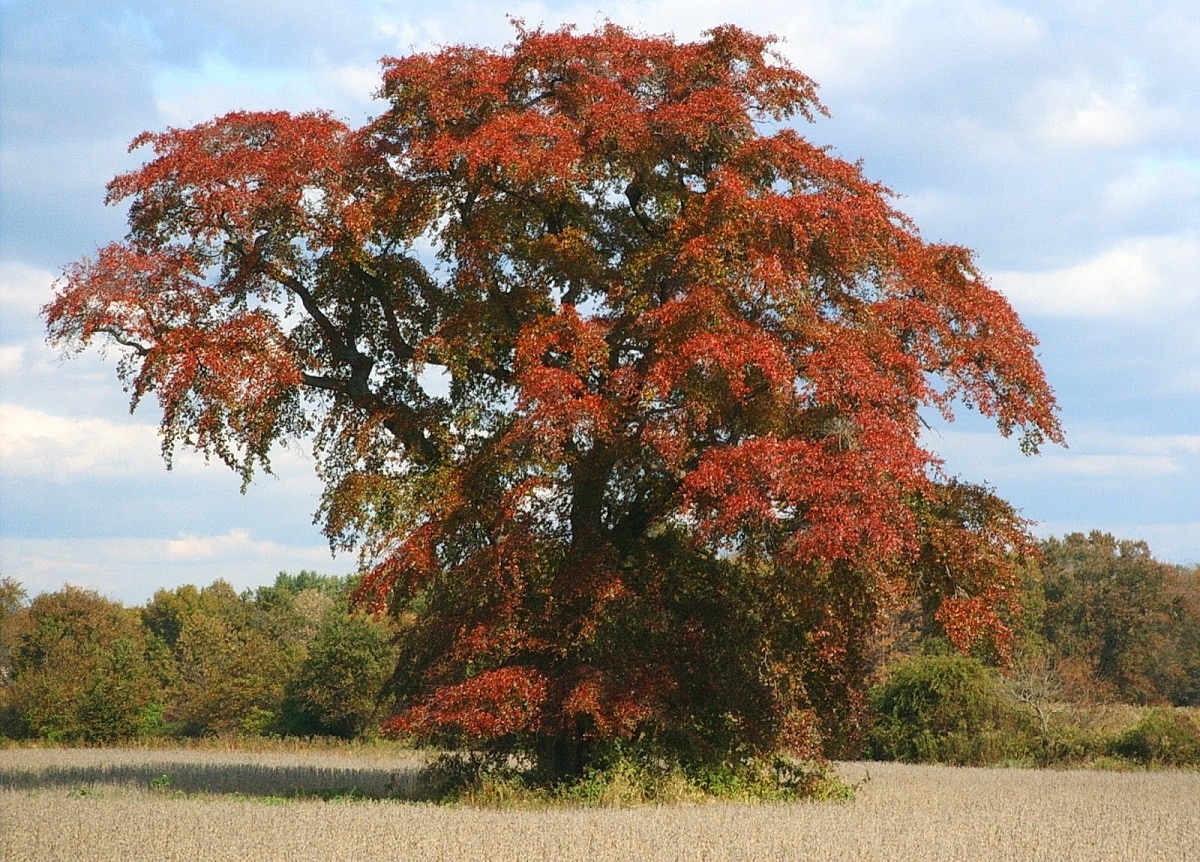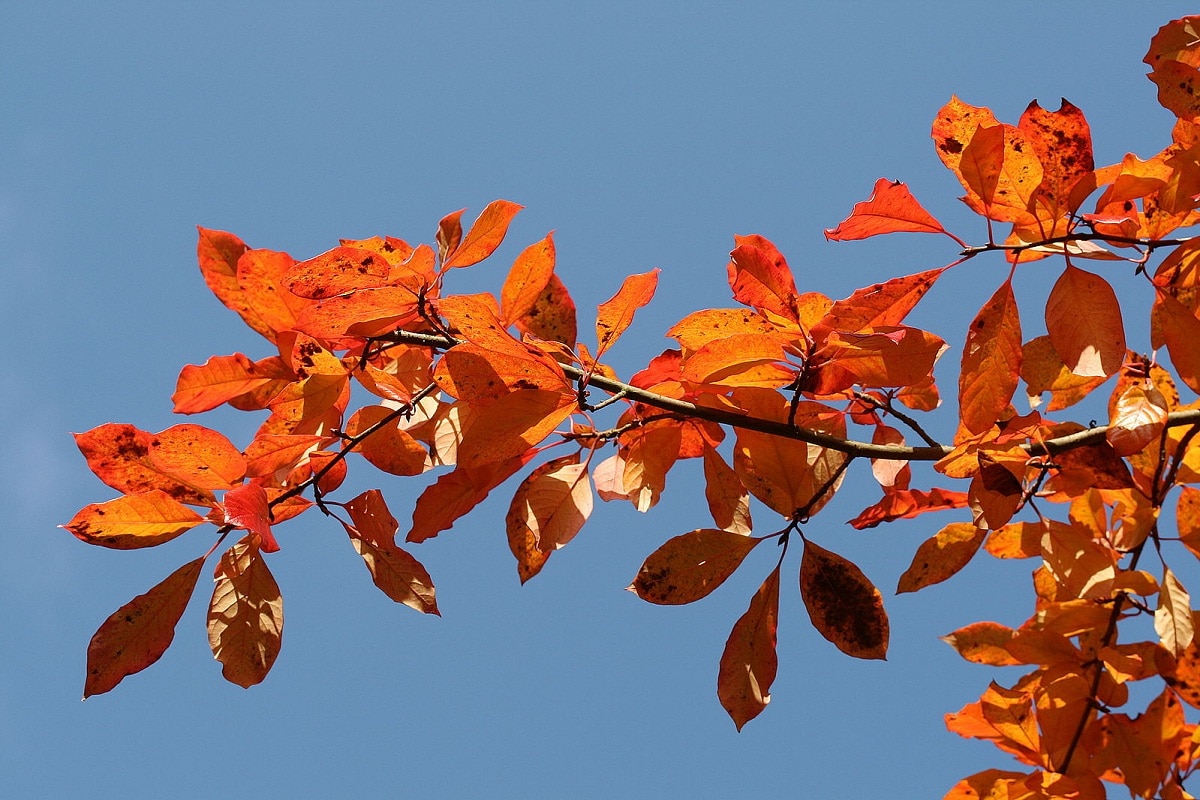
One of the ornamental trees used in parks and gardens is the nyssa sylvatica. It is also known by the name of tupelo or nisa. It belongs to the Nyssaceae family and this family has 6 species of arboreal growth. It is a type of plant whose origin comes from eastern North America. It is widely used for the decoration of parks and gardens since it has very attractive leaves.
In this article we are going to tell you all the characteristics, cultivation, pests and diseases of the nyssa sylvatica.
Key features

This plant is a deciduous tree that can grow up to 20 meters high if they are in their natural state and grows in good condition. They are characterized by having a rounded crown and extended branches. The advantage offered by this tree is that it is easy to prune and can favor the decoration of green public spaces. The leaves of this tree are elliptical and somewhat leathery and have a glossy dark green color. What stands out most about these leaves is that during the autumn season they turn a carmine color that favors attractiveness.
Being a deciduous tree, it has leaves during winter and loses ornamental value. However, it is a seasonal tree and in summer it provides very good shade for lucrative activities and to reduce the summer heat. Flowering begins in early summer and the flowers are very small in size. They have a greenish-white color very little in showy. As we have mentioned before, what stands out the most about this tree are its leaves.
Basic care of the nyssa sylvatica

Location and irrigation
We are going to talk now about the different care it needs and the requirements so that it can grow in good conditions. As it is not too tall a tree, it can be kept in a private garden to have a decorative function. The first of all is to know the location of the tree. It is a type of plant that needs to be grown in full sun. It also needs a climatic zone where low temperatures predominate. We speak of a range of Annual average temperatures between 10-20 degrees.
It takes more or less 10 years to reach maturity and that is when you have to protect it from late frosts. Late frosts are those that occur when spring begins but the atmosphere has not acclimatized. This factor affects not only its growth, but also the annual flowering. From 10 years of age it becomes a fairly rustic tree. From this age, it is not necessary to protect it from frost since it becomes more resistant.
Regarding irrigation, they should be carried out normally once or twice a week and increasing them slightly in the summer time and decreasing in the winter time. If the climatic zone where you live tends to have abundant rainfall in the winter season, it is not necessary to water. Rainwater is sufficient, as long as it maintains a good humidity level.
Soil and transplant
Now we are going to talk about the type of soil that is needed for the nyssa sylvatica can develop well. It requires a soil rich in humus that has a good capacity to retain water. Contrary to what occurs with many plants, the nyssa sylvatica it needs good water reception and poorly drained soil. On the other hand, the planting in the final place should be done in the period between autumn and spring of the following year. And it is that this plant is affected if many transplants are carried out, so the young plant should not be taken to its final location until it reaches a suitable size.
As for the fertilizer, it is not necessary to fertilize this tree, as long as the soil is rich in organic matter and one point will suffice with a simple annual manure that will be applied to the entire garden including this tree. If the soil is somewhat poorer, it may be interesting to supply some type of fertilizer during the maximum growth period. This is in the 10 years before reaching maturity. It is during the first years of development that it is most vulnerable to adverse environmental conditions. Therefore, it is convenient to place it in a well-protected place.
Multiplication of the nyssa sylvatica

In order to multiply this tree, it is convenient to use seeds planted in a cold box. When the little seedlings have grown a little, they will peal one by one in other pots. This species can also be propagated by layering in spring. This type of propagation is faster than by seeds.
It is often used for alignment in parks or lakes and other green public spaces. In addition, it has a highly valued wood for small-sized manufactures. It is a tree that has us state headquarters for pests and diseases, although the greatest danger that it can run is that it is affected by late frosts. If the area where you live usually has frosts at the end of winter, when the temperatures begin to rise, it is better to protect it as well as possible.
There is no doubt that it is a very ornamental species that reaches its maximum splendor when autumn arrives. Its scarlet, red and yellow coloration can create a very cozy garden. The same goes for public green spaces. If you want to multiply it by seeds, you need to do some stratification in the soil first to improve the extension of the roots. It supports different types of soils, whether they are somewhat more acidic or alkaline. The important thing is that it has good levels of organic matter and a high degree of humidity. If you see that the base of the tree is flooded you should not worry. Just ensure that temperatures are in the 10-20 degree range and that there are no late frosts. The rest is very easy.
I hope that with this information you can learn more about the nyssa sylvatica and their characteristics.